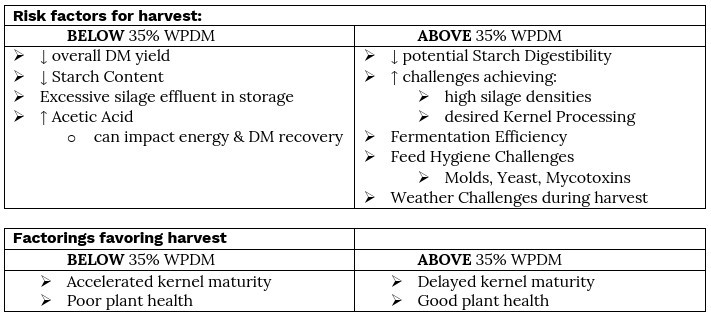Corn Silage: Rain Following Dry Conditions
By Joe Lawrence; PRO-DAIRY
The 2025 growing season has experienced many extremes. Recently several areas have received much needed rain and while it has not been enough to alleviate the dry conditions for most, it has been enough to "perk up" some corn fields.
The following reminders and guidelines apply to corn that has a developed ear and in the maturation phase as this rain is received. For the numerous acres of very late planted corn that are still developing ears, the recent articles on Late season forage considerations (2025) and immature corn silage remain applicable.
These scenarios, with rain following the dry conditions, often triggers a final effort by the corn plant to finish its lifecycle, putting energy into kernel development. It is important to watch for this in your corn fields and let the process play out. The challenge is this can further delay proper corn silage harvest timing but with this challenge comes opportunity. The opportunity being improvements in overall forage value of the silage when patience is exercised and the corn plants are able to make up for some of the limitations from the season long weather challenges.
While we should not expect any miracles with these stressed corn fields, allowing the plants to utilize this recent moisture to put resources into finishing kernel development can improve overall yield and starch content compared to being too hasty with harvest timing.
Considerations
• When corn plants have access to this late season moisture following dry conditions, achieving proper plant maturity for silage harvest takes longer than growing degree day (GDD) projections indicate. GDD projections can still be useful for grouping fields by planting dates and hybrid relative maturities but realize actual harvest timing will be delayed past the projected GDD's needed.
• Plant health needs to be considered when balancing the tradeoffs of harvesting a stressed crop (table 1). With good plant health, following harvest targets of 35 percent whole plant dry matter and two-thirds kernel milkline will help optimize yield and forage nutritional value. However, when plant health is poor, harvesting when whole plant dry matter is in the low 30's and/or kernel milkline is less than two-thirds may be warranted to avoid potential negative impacts to fiber digestibility and increased risk of mold and toxins issues.
Drought and forage nitrate considerations
Any time drought conditions occur, questions arise regarding the potential for problematic nitrate levels in forages. While this risk is real, the practical scenarios where it is of concern are limited to feeding green chop forage harvested within a short window after a "drought ending" rain. The risk with properly fermented forages harvested several days after the rain event are very low.
• Delaying harvest for several days after the rain event will allow time for the plant to process the excess nitrate taken up from the soil following the rain.
• Proper fermentation will reduce nitrate concentrations in the forage even if harvest occurred before the plants had time to process the excess nitrate.
• An important note here is that while the risk to livestock is minimized, ensiling high nitrate forages can increase the risk of silo gases developing during the fermentation process and extra precautions should be taken when working around silos containing these forages.
TABLE 1: Considerations for harvest above or below target corn maturity

Upcoming Events
NY Small Farms Summit 2025: Stronger Together
December 5, 2025
Alfred, NY
We hope you will join us on December 5th for the 2025 New York Small Farms Summit! This is an opportunity to meet other farmers and ag supporters, learn about research and education projects, and set priorities for future efforts to grow small farm success.
At the Allegany County site, we will focus on giving trees a chance and how trees build resiliency on small farms. Whether attracted to fruit, nuts, vegetables, fodder or shade, trees can be an integral part of a successful farming system. Join us as we explore the opportunities for resiliency that come from adding tree crops or managing wooded areas of your farm for agroforestry or silvopasture systems.
Crops, Cows & Critters - Southwest New York Dairy, Livestock & Field Crops Newsletter Sponsorship
December 19, 2025
Our two forms of publications feature research-based and timely information from our four specialists, listed to the right, along with local event notifications and Cornell University outreach. This information is provided to participants who range from dairy, livestock, and field crops producers to agricultural suppliers and consultants.
Weekly Email Update: Shared with 625+ households who have signed up with our program.
Monthly Paper Mailer: To reach our stakeholders and farmers who lack internet access, we send out a monthly mailer where your company's logo and contact information would be featured with a mailing list of 330+ households.
If you sponsor our weekly and monthly publications you reach approximately 955 households.
Visit our website to view our newsletters!
Announcements
No announcements at this time.





